Evaluation of the Correlation Between the Organic Food Sector and Rural Development in Bulgaria: Case Study
Abstract
1. Introduction
2. Context of This Study
3. Opportunities for the Application of Organic Farming for Rural Development in Bulgarian Conditions Under European Integration
4. Materials and Methods
4.1. Research Methodology
4.2. Statistical Methods of Analysis
4.3. Survey
4.3.1. Questionnaire
4.3.2. Sample
4.4. SWOT Analysis
- Defining the Objectives and Scope. The first step is to clarify the purpose, geographical scope, and thematic focus of the SWOT analysis. These parameters determine the necessary competencies among the experts [92].
- Identification of Expert Profiles. Expert profiles are derived from the Quadruple Helix sectors: Academia, Researchers in agroecology, agricultural economics, and organic systems; Business, Organic producers, processors, and sectoral associations; Government, Policymakers and regulatory bodies; Civil Society, NGOs, consumer groups, and certification authorities.
- Selection Criteria. Experts are evaluated based on a competency matrix, including:
- ✓
- Minimum five years of relevant experience.
- ✓
- Advanced academic qualifications.
- ✓
- Authorship of publications or strategic documents.
- ✓
- Institutional and geographical diversity.
- ✓
- Declaration of no conflict of interest.
- Identification Strategies. Candidate identification includes public calls, targeted invitations, and institutional nominations. This hybrid approach ensures both inclusivity and relevance [93].
- Evaluation Procedure. A selection committee applies a scoring rubric to assess each candidate across predefined criteria [77]. Scores determine the final composition of the expert group, which is optimized for both thematic and regional balance.
- Ethical Considerations. All selected participants must sign the following documents: Consent to Participate, Declaration of No Conflict of Interest, and Confidentiality Agreement (if applicable).
5. Results
5.1. Analysis of Key Demographic and Economic Indicators for Municipalities and the Potential for Developing Organic Farming
5.2. Evaluation of the Relation Between the Bulgarian Organic Food Market and the Development of Rural Areas Development
- Strengths assessment. The strengths with the highest overall scores, indicating their strategic importance, are:
- Growing demand for healthy foods and environmentally friendly products (total score: 190). This is the most important strength. It highlights the macro trend in consumer behaviour, driving the growth of the organic market. This is a strong pull factor that justifies increased investment and policy focus. This growth in demand is not just a passing trend but a lasting change in consumer behaviour.
- Favorable natural and climatic conditions (overall score: 159) and Availability of specific traditional Bulgarian products suitable for organic production (overall score: 143). This highlights Bulgaria’s natural comparative advantage in organic production, which can be leveraged to sustainably expand the sector. Additionally, organic production is a significant force for the entire sector at the national level. The combination of favorable natural and climatic conditions, along with the use of specific traditional products, is a critical structural force driving the development of the organic market in Bulgaria. Rural areas in Bulgaria are characterized by diverse agro-ecological zones, rich soils, and a temperate continental climate, which together support the cultivation of a wide variety of crops without the intensive use of synthetic fertilizers.
- 2.
- Weakness assessment. The most critical weaknesses with high overall scores include:
- Insufficient subsidies for organic production (total score: 212). This is the most significant internal barrier. Lack of adequate subsidies for organic production stands out as the most critical internal weakness. The weakness highlights a structural gap in agricultural policy and financial support mechanisms, particularly in comparison to other EU Member States. This problem is particularly acute in Bulgaria, where the majority of organic farms are small or family-run, often lacking access to capital and risk-mitigation tools. Furthermore, the lack of consistency and transparency in subsidy allocation policies further weakens the sector.
- Insufficient public awareness of organic products (overall score: 201). One of the most critical internal weaknesses identified in the SWOT analysis of the Bulgarian organic market is the low level of public awareness and understanding of organic products. Despite growing global trends towards healthy consumption and environmentally sustainable agricultural practices, a significant portion of the Bulgarian population remains poorly informed about the nature, benefits, and distinguishing characteristics of organic products compared to conventional alternatives.
- The presence of fakes and imitations (total score: 147). This is recognised as a very significant internal weakness of the Bulgarian organic market, which is reflected in its overall score of 147 in the SWOT matrix. Despite the identified weakness, the sociological survey shows an opposite trend. Most respondents are aware that organic products should have a label on their packaging that guarantees their organic status (Figure 14).
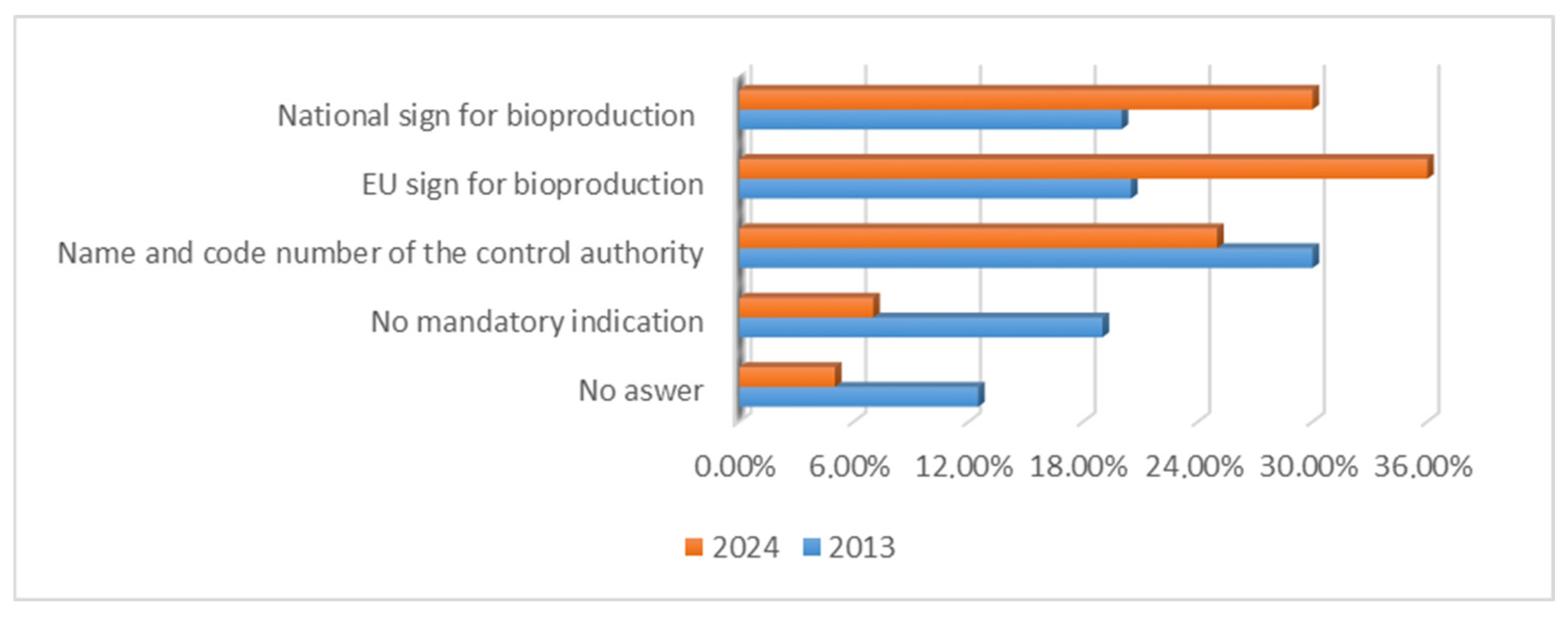
- 3.
- Opportunity assessment. Based on the overall assessment, the most attractive and significant opportunities are:
- Expanding the range of products available in the retail chain (score 289) and offering organic products in other types of outlets (score 229). The results of the survey show that organic products are most widely available in supermarket and hypermarket chains and are typically found on dedicated stands (Figure 15). The increase in the percentage of organic products purchased from specialised organic shops is striking, as these outlets offer a wider range and variety of products (13% in 2013; 32% in 2024).

- Increase organic production to diversify supply. With an overall score of 260 points, increasing organic production to diversify market supply is a strategic lever to strengthen the Bulgarian organic sector. This opportunity is supported by broader macro trends in consumer behavior, particularly the growing preference for organic, health-oriented, and environmentally sustainable products.
- 4.
- Threat assessment. The most serious external threats, according to their overall assessment, are:
- Decline in consumption due to high product prices (208), insufficient popularity of organic products (108), and decline in production due to inadequate subsidies (128). Consumption dynamics are highly dependent on both prices and insufficient popularity, as demonstrated by the results in the period 2013–2014. Demand constraints risk hampering the expansion and sustainability of the organic sector in Bulgaria. This result highlights a critical structural barrier that affects both current consumption patterns and the potential for market expansion. The two factors strongly influencing demand and consumption threaten the sector’s potential growth in Bulgaria, which will inevitably affect rural dynamics. The higher price is explained by both the specificity of the products and the more limited supply, usually caused by insufficient subsidies. This highlights the need for targeted policy interventions, supply chain optimisation, consumer awareness strategies, and public policy.
6. Discussion
7. Conclusions
Author Contributions
Funding
Institutional Review Board Statement
Informed Consent Statement
Data Availability Statement
Conflicts of Interest
Appendix A
| Descriptive Data | ||
|---|---|---|
| Total | 244 | |
| Entity | n | % |
| Sofia | 45 | 18.44 |
| Plovdiv | 33 | 13.52 |
| Stara Zagora | 21 | 8.60 |
| Burgas | 26 | 10.65 |
| Varna | 29 | 11.89 |
| Shumen | 13 | 5.32 |
| Pleven | 9 | 3.69 |
| Vratza | 4 | 1.64 |
| Gender | ||
| Male | 85 | 34.84 |
| Female | 95 | 38.93 |
| Age | ||
| up to 29 | 25 | 10.25 |
| 29–39 | 35 | 14.34 |
| 40–49 | 30 | 12.29 |
| 50–59 | 40 | 16.39 |
| over 60 | 50 | 20.49 |
| Education | ||
| Primary | 0 | 0 |
| Secondary | 0 | 0 |
| Diploma | 30 | 12.29 |
| Bachelors | 60 | 24.59 |
| Masters | 80 | 32.79 |
| Doctorate | 10 | 4.09 |
| Ocupation | ||
| Student | 40 | 16.39 |
| Employee | 71 | 29.09 |
| Independent worker | 34 | 13.93 |
| Homemaker | 15 | 6.15 |
| Retired | 20 | 8.19 |
| Other | 0 |
| Descriptive Data | N | % |
|---|---|---|
| Entity | ||
| North Western Region | 2 | 7.69 |
| North Central Region | 4 | 1.54 |
| North Eastern Region | 4 | 1.54 |
| South Western Region | 7 | 26.92 |
| South Central Region | 4 | 1.54 |
| South Eastern Region | 5 | 19.23 |
| Gender | ||
| Male | 17 | 65.38 |
| Female | 9 | 34.62 |
| Age | ||
| up to 29 | 1 | 3.85 |
| 30–39 | 2 | 7.69 |
| 40–49 | 6 | 23.08 |
| 50–59 | 7 | 26.92 |
| over 60 | 10 | 38.46 |
| Education | ||
| Primary | 0 | 0 |
| Secondary | 0 | 0 |
| Diploma | 2 | 7.69 |
| Bachelors | 7 | 26.92 |
| Masters | 17 | 65.38 |
| Doctorate | 0 | 0 |
| Descriptive Data | N | % |
|---|---|---|
| Entity | ||
| North Western Region | 3 | 7.89 |
| North Central Region | 6 | 15.79 |
| North Eastern Region | 9 | 23.68 |
| South Western Region | 8 | 21.05 |
| South Central Region | 7 | 18.42 |
| South Eastern Region | 5 | 13.16 |
| Gender | ||
| Male | 31 | 81.58 |
| Female | 8 | 18.42 |
| Age | ||
| up to 29 | 2 | 5.26 |
| 30–39 | 6 | 15.79 |
| 40–49 | 9 | 23.68 |
| 50–59 | 11 | 28.95 |
| over 60 | 10 | 26.32 |
| Education | ||
| Primary | 0 | 0 |
| Secondary | 0 | 0 |
| Diploma | 3 | 7.89 |
| Bachelors | 14 | 36.84 |
| Masters | 21 | 55.26 |
| Doctorate | 0 | 0 |
| SWOT Matrix | OPPORTUNITIES | THREATS | |||||||||||
|---|---|---|---|---|---|---|---|---|---|---|---|---|---|
| Building Skills and Competence for Strategic Management | Cooperation in Strategic Planning | Sharing the Financial Costs of Creating and Implementing Innovations | New Business Models Enabling Increased Corporate Competitiveness | Establishment of Mutual Financial Funds | Monopolistic Market Structure | Strong Dependence on Commercial Banks’ Credit Policy | Insufficient Supply of Experienced Strategic Planning Specialists in the Labor Market | Increased Competition, with Large Players Becoming Increasingly Aggressive Towards the Market Share of Smaller Market Players | Unequal Access to State Financial Assistance and Subsidies | ∑ of the row scores | |||
| STRENGTHS | Adaptable and motivated to achieve sales growth | 66 | 30 | 71 | 79 | 95 | 30 | 33 | 19 | 95 | 33 | 551 | 2503 |
| Liquid | 33 | 59 | 81 | 30 | 60 | 25 | 91 | 26 | 19 | 11 | 435 | ||
| Striving to introduce innovations in production | 95 | 55 | 75 | 15 | 55 | 91 | 75 | 57 | 85 | 28 | 631 | ||
| Diversify sources of financial risk | 91 | 99 | 61 | 45 | 45 | 9 | 87 | 8 | 30 | 55 | 530 | ||
| They have a stable market share | 80 | 65 | 59 | 12 | 11 | 15 | 65 | 16 | 20 | 13 | 356 | ||
| WEAKNESSES | High indebtedness | 60 | 91 | 71 | 44 | 41 | 30 | 99 | 65 | 11 | 15 | 527 | 2396 |
| Insufficient working capital | 95 | 33 | 81 | 15 | 19 | 59 | 54 | 11 | 57 | 51 | 475 | ||
| Do not diversify sources of market risk | 15 | 30 | 11 | 19 | 25 | 81 | 77 | 19 | 83 | 77 | 437 | ||
| Systemic gaps in the implementation of strategic activities | 59 | 79 | 35 | 63 | 51 | 11 | 61 | 71 | 95 | 11 | 536 | ||
| They do not have the conditions to attract experienced strategists/ They do not have a separate strategic unit | 93 | 31 | 9 | 33 | 33 | 9 | 11 | 85 | 28 | 89 | 421 | ||
| ∑ of the ratings in the column | 687 | 572 | 554 | 355 | 435 | 360 | 653 | 377 | 523 | 383 | |||
References
- European Commission. Organic Farming in the EU: A Decade of Growth, 2023. Available online: https://agriculture.ec.europa.eu/media/news/organic-farming-eu-decade-growth-2023-01-18_en (accessed on 1 January 2020).
- USDA. U.S. Organic Food Market Trends and Growth Analysis. 2023. Available online: https://www.usda.gov/topics/organic (accessed on 12 May 2025).
- Voronkova, O.Y.; Kovaleva, I.V. The sustainable socio-economic development of rural areas in terms of development of organic farming. In IOP Conference Series: Materials Science and Engineering; IOP Publishing: Bristol, UK, 2020; Volume 753, p. 082016. [Google Scholar] [CrossRef]
- Abdullah, M.; Parvin, S.S. Organic Farming through Sustainable Production, Its Socio-Economic Impacts in Rural Livelihood and for Community Development. Appl. Agric. Sci. 2024, 2, 1–11. [Google Scholar] [CrossRef]
- Surya, B.; Saleh, H.; Idris, M. Rural agribusiness-based agropolitan area development and environmental management sustainability: Regional economic growth perspectives. Int. J. Energy Econ. Policy 2021, 11, 142–157. [Google Scholar] [CrossRef]
- Sá, C.P.D.; Pagani, R.N.; Przybysz, A.L.; Souza, F.F.D.; Resende, D.N.; Kovaleski, J.L. Towards the Concept of Smart Municipality: Agribusiness Model Integrating Rural and Urban Areas for Organic Food Production: A Review. Sustainability 2025, 17, 1015. [Google Scholar] [CrossRef]
- Miftari, I.; Haas, R.; Meixner, O.; Imami, D.; Gjokaj, E. Factors influencing consumer attitudes towards organic food products in a transition economy—Insights from Kosovo. Sustainability 2022, 14, 5873. [Google Scholar] [CrossRef]
- FiBL & IFOAM. The World of Organic Agriculture: Statistics & Emerging Trends 2023. Available online: https://www.fibl.org (accessed on 10 January 2025).
- Eurostat. Available online: https://ec.europa.eu/eurostat/databrowser/explore/all/agric?lang=en&subtheme=agr.org&display=list&sort=category&extractionId=org_cropar (accessed on 10 January 2025).
- FiBL. Available online: https://www.fibl.org/en/ (accessed on 10 January 2025).
- NSI. Available online: https://www.nsi.bg/statistical-data/258 (accessed on 10 January 2025).
- Database of Producers, Processors and Traders of Agricultural Products and Foods Produced Organically Ministry of Agriculture, Food and Forestry. Available online: https://bioreg.mzh.government.bg/ (accessed on 10 January 2025).
- Selvan, T.; Panmei, L.; Murasing, K.K.; Guleria, V.; Ramesh, K.R.; Bhardwaj, D.R.; Thakur, C.L.; Kumar, D.; Sharma, P.; Digvijaysinh Umedsinh, R.; et al. Circular economy in agriculture: Unleashing the potential of integrated organic farming for food security and sustainable development. Front. Sustain. Food Syst. 2023, 7, 1170380. [Google Scholar] [CrossRef]
- European Environment Agency. Impact of Organic Farming on Climate Change and Biodiversity, 2022. Available online: https://www.eea.europa.eu/publications (accessed on 11 May 2025).
- Dabbert, S.; Häring, A.M.; Zanoli, R. Impact of Rural Development Programmes on Organic Farming, 2021. ResearchGate. Available online: https://www.researchgate.net/publication/233425821 (accessed on 20 June 2025).
- EU CAP Network. Impact of Bio-Based Strategies on Rural Development. 2023. Available online: https://eu-cap-network.ec.europa.eu (accessed on 2 May 2025).
- Chiripuci, B.; Popescu, M.F.; Constantin, M. The European Consumers’ Preferences for Organic Food in the Context of the European Green Deal. Amfiteatru Econ. 2022, 24, 361–378. [Google Scholar] [CrossRef]
- Rana, J.C.; Bisht, I.S. Reviving smallholder hill farming by involving rural youth in food system transformation and promoting community-based agri-ecotourism: A case of Uttarakhand state in north-western India. Sustainability 2023, 15, 8816. [Google Scholar] [CrossRef]
- Reganold, J.P.; Wachter, J.M. Organic Agriculture in the 21st Century. Nat. Plants 2016, 2, 15221. [Google Scholar] [CrossRef] [PubMed]
- Clark, M.; Tilman, D. Comparative Analysis of Environmental Impacts of Agricultural Production Systems, Agricultural Input Efficiency, and Food Choice. Environ. Res. Lett. 2017, 12, 064016. [Google Scholar] [CrossRef]
- Tuomisto, H.L.; Hodge, I.D.; Riordan, P.; Macdonald, D.W. Does Organic Farming Reduce Environmental Impacts? A Meta-Analysis of European Research. J. Environ. Manag. 2012, 112, 309–320. [Google Scholar] [CrossRef]
- Tsonkov, N. Water Sector Management And Sustainable Development Of Bulgarian Regions. MEST J. 2021, 9, 75–80. [Google Scholar] [CrossRef]
- Tsonkov, N.; Petrov, K. Global Challenges for Regional Policy and Development. Vanguard Sci. Instrum. Manag. 2024, 20, 196–207. [Google Scholar]
- Nikolova, M.; Slaveva, K.; Pavlov, P. Organic Agriculture in the Republic of Bulgaria: A Model for Sustainable Development and Diversification of Agricultural Business. Sustainability 2025, 17, 3249. [Google Scholar] [CrossRef]
- White, K. Small T Small Town and Rur own and Rural Economic De conomic Development: A Case Study. Anal. Strateg. Success. SPNHA Rev. 2022, 18, 59–74. [Google Scholar]
- Ahlmeyer, F.; Volgmann, K. What Can We Expect for the Development of Rural Areas in Europe?—Trends of the Last Decade and Their Opportunities for Rural Regeneration. Sustainability 2023, 15, 5485. [Google Scholar] [CrossRef]
- Hussain, S.; Maqbool, R.; Hussain, A.; Ashfaq, S. Assessing the Socio-Economic Impacts of Rural Infrastructure Projects on Community Development. Buildings 2022, 12, 947. [Google Scholar] [CrossRef]
- Akkoyunlu, S. The Potential of Rural–Urban Linkages for Sustainable Development and Trade. Int. J. Sustain. Dev. World Policy 2015, 4, 20–40. [Google Scholar] [CrossRef]
- Doitchinova, J.; Stoyanova, Z. Activation of local communities for development of rural areas. Econ. Agric. 2014, 61, 661–675. [Google Scholar] [CrossRef]
- Doitchinova, J.; Lazarova, E. Demographic changes and inequalities: Regional differences with a focus on rural area in Bulgaria. Sci. Papers. Ser. Manag. Econ. Eng. Agric. Rural. Dev. 2023, 23, 261–269. [Google Scholar]
- Nikolova, M.; Nenova, R. Classification of the NUTS 3 Regions in Bulgaria: Focus on Utilized Agricultural Area Categories. J. Mt. Agric. Balk. 2022, 25, 281–319. [Google Scholar]
- Nikolova, M. Problems and opportunities for realization of Bulgarian organic production. Trakia J. Sci. 2019, 17 (Suppl. 1), 259–267. [Google Scholar] [CrossRef]
- Petrova, M.; Lazarova, E.; Pavlov, P.; Shalbayeva, S. Analysis and Assessment of Infrastructural Potential in Rural Territories. Economics. Ecol. Socium 2023, 7, 1–14. [Google Scholar]
- Stanimirova, M.; Zarev, Y. The Role of Consulting Organizations in the Transfer of Innovations in Rural Areas. In Information Society and Sustainable Development: 6th International Conference: ISSD 2019: Proceedings, Târgu-Jiu, Romania, 10–11 May 2019; Academica Brancusi Publishing House: Târgu-Jiu, Romania, 2019. [Google Scholar]
- Nikolova, M.; Linkova MPavlov PLazarova, E. Theoretical and methodological basis in the management of sustainable development of rural territories in the Republic of Bulgaria. Agric. Sci.-Open Access J. 2022, 14, 37–48. [Google Scholar] [CrossRef]
- Slaveva, K.; Naydenov, S.; Nikolova, M.; Pavlov, P. The economic centers in Bulgaria—An opportunity to discover additionalpotential in the regional development of rural territories. Sci. Pap. Ser. Manag. Econ. Eng. Agric. Rural Dev. 2024, 24, 847–856. [Google Scholar]
- Slavova, P.; Moschitz, H.; Georgieva, Z. Development of Organic Agriculture in Bulgaria (1990–2012): Actors, Relations, and Networks. Sociol. Rural. 2017, 57, 507–528. [Google Scholar] [CrossRef]
- Stoeva, S.; Slavova, P.; Georgieva, Z. Development of the Organic Sector in Post-Socialist Bulgaria 1990–2013. Build. Org. Bridges 2014, 1, 93–96. [Google Scholar]
- Agapieva-Aliosman, V.; Dirimanova, V. The role of organic farming for the development of agricultural sector in Bulgaria. Sci. Pap. Ser. Manag. Econ. Eng. Agric. Rural. Dev. 2021, 21, 13–18. [Google Scholar]
- Terziev, V.; Arabska, E. Sustainable Rural Development through Organic Production and Community-Supported Agriculture in Bulgaria. Bulg. J. Agric. Sci. 2016, 22, 527–535. [Google Scholar]
- Arabska, E. Opportunities for Sustainable Rural Development in Bulgaria, 2016. Available online: https://www.researchgate.net/publication/291353290_Opportunities_for_sustainable_rural_development_in_Bulgaria (accessed on 10 May 2025).
- Otouzbirov, R.; Atanasova, T.; Nencheva, I. Sustainable Development of Organic Farming in Bulgaria—State and Opportunities. Cent. Eur. Rev. Econ. Manag. 2019, 3, 89–97. [Google Scholar] [CrossRef]
- Arabska, E. Improvement of National Strategic Framework in Organic Production and Management in the Republic of Bulgaria, 2017. Available online: https://www.researchgate.net/publication/316596509_IMPROVEMENT_OF_NATIONAL_STRATEGIC_FRAMEWORK_IN_ORGANIC_PRODUCTION_AND_MANAGEMENT_IN_THE_REPUBLIC_OF_BULGARIA (accessed on 29 April 2025).
- Arabska, E. Trends in Organic Farming Development in Bulgaria: Applying Circular Economy Principles to Sustainable Rural Development, 2017. Available online: https://www.researchgate.net/publication/318183798_Trends_in_Organic_Farming_Development_in_Bulgaria_Applying_Circular_Economy_Principles_to_Sustainable_Rural_Development (accessed on 29 April 2025).
- Petrova, M. An Innovative Organic Agriculture Model for Sustainable Development of Rural Areas in Bulgaria, 2023. Available online: https://www.researchgate.net/publication/367243777_An_Innovative_Organic_Agriculture_Model_for_Sustainable_Development_of_Rural_Areas_in_Bulgaria (accessed on 29 April 2025).
- Scialabba, N.E.-H.; Müller-Lindenlauf, M. Organic Agriculture and Climate Change. Renew. Agric. Food Syst. 2010, 25, 158–169. [Google Scholar] [CrossRef]
- Herman, E. Sustainable Agriculture and Its Impact on the Rural Development in EU Countries: A Multivariate Analysis. Land 2024, 13, 947. [Google Scholar] [CrossRef]
- Stoeva, S. Opening the “Black Box” of organic Agriculture in Bulgaria: The Problem with Top-down Institutional Development. East. Eur. Countrys. 2024, 22, 85–105. [Google Scholar] [CrossRef]
- Häring, A.M.; Dabbert, S.; Zanoli, R. Economic and Social Impact of Organic Farming in the EU. Research Gate, 2021. Available online: https://www.researchgate.net/publication/308265361_Sustainable_rural_development_through_organic_production_and_community-supported_agriculture_in_Bulgaria (accessed on 19 February 2025).
- Willer, H.; Lernoud, J. The World of Organic Agriculture: Statistics and Emerging Trends; FiBL & IFOAM: Frick, Switzerland, 2021. [Google Scholar]
- Gracheva, R.G.; Sheludkov, A.V. Diffusion of organic agriculture in Russia: Features and implications for rural development. Reg. Res. Russ. 2021, 11, 578–588. [Google Scholar] [CrossRef]
- Tsonkov, N. Opportunities For Structuring Regional Business And Utility Systems In Municipalities. Ger. Int. J. Mod. Sci. 2024, 92, 97–102. [Google Scholar] [CrossRef]
- Borisov, P.; Petrov, K.; Tsonkov, N. Integration perspectives for improving regional policy in rural areas of Bulgaria. Agric. Resour. Econ. Int. Sci. E-J. 2024, 10, 260–283. [Google Scholar]
- Molpeceres, C.; De Rito, M.; Zulaica, L.; Mikkelsen, C. Toward sustainability of local development in rural areas: New alternative productive scenarios in General Pueyrredon District, Argentina. Local Dev. Soc. 2021, 2, 271–291. [Google Scholar] [CrossRef]
- Mihai, F.C. Circular economy and sustainable rural development. Sustainability 2023, 15, 2139. [Google Scholar] [CrossRef]
- Kuandykova, M.; Akpanov, A.; Tleubayeva, S.; Belgibayev, A.; Makhmudov, A.; Atchabarova, A. Attracting investment for rural development: Introduction of organic agriculture and ESG principles in Kazakhstan. J. Environ. Manag. Tour. 2023, 14, 2196–2206. [Google Scholar] [CrossRef] [PubMed]
- Unay-Gailhard, İ.; Bojnec, Š. The impact of green economy measures on rural employment: Green jobs in farms. J. Clean. Prod. 2019, 208, 541–551. [Google Scholar] [CrossRef]
- Kujala, S.; Hakala, O.; Viitaharju, L. Factors affecting the regional distribution of organic farming. J. Rural. Stud. 2022, 92, 226–236. [Google Scholar] [CrossRef]
- Petrov, K.; Tsonkov, N. Trends in the regional development of medium-sized municipalities with a population between 10 and 50 thousand in Eastern Bulgaria. Edelweiss Appl. Sci. Technol. 2025, 9, 879–895. [Google Scholar] [CrossRef]
- Bonfiglio, A.; Arzeni, A. Spatial distribution of organic farms and territorial. Bio-Based Appl. Econ. 2019, 8, 297–323. [Google Scholar] [CrossRef]
- Paffarini, C.; Sini, M.P. Rural Sustainability and Food Choice: The Effect of Territorial Characteristics on the Consumers’ Preferences for Organic Lentils. Research Gate; 2021. Available online: https://www.researchgate.net/publication/354016913 (accessed on 20 March 2025).
- Canwat, V.; Onakuse, S. Organic agriculture: A fountain of alternative innovations for social, economic, and environmental challenges of conventional agriculture in a developing country context. Clean. Circ. Bioeconomy 2022, 3, 100025. [Google Scholar] [CrossRef]
- Petrova-Hristova, K. Bulgarian Agriculture-Principles, Traditions and Development of the Organic Agriculture. Recent Adv. Inf. Technol. Tour. Econ. Manag. Agric. 2022, 6, 381. [Google Scholar]
- Chereji, A.I.; Chiurciu, I.A.; Popa, A.; Chereji, I.; Iorga, A.M. Consumer behaviour regarding food waste in Romania, rural versus urban. Agronomy 2023, 13, 571. [Google Scholar] [CrossRef]
- Leyva-Hernández, S.N.; Toledo-López, A.; Hernández-Lara, A.B. Purchase intention for organic food products in Mexico: The mediation of consumer desire. Foods 2021, 10, 245. [Google Scholar] [CrossRef] [PubMed]
- Yazdanpanah, M.; Forouzani, M. Application of the Theory of Planned Behaviour to predict Iranian students’ intention to purchase organic food. J. Clean. Prod. 2015, 107, 342–352. [Google Scholar] [CrossRef]
- Avrămescu, T.C. Rural Development Opportunities in the Romanian Bioeconomy. Agric. Manag./Lucr. Stiintifice Ser. I Manag. Agric. 2020, 22, 15–22. [Google Scholar]
- Tiwari, A.K. The role of organic farming in achieving agricultural sustainability: Environmental and socio-economic impacts. Acta Biol. Forum 2023, 2, 29–32. [Google Scholar] [CrossRef]
- Kovalenko, E.G.; Yakimova, O.Y.; Polushkina, T.M.; Igaikina, I.I. Competitiveness of rural areas due to development of organic agriculture. In International Conference on Trends of Technologies and Innovations in Economic and Social Studies; Atlantis Press: Dordrecht, The Netherlands, 2017; pp. 348–354. [Google Scholar]
- Cristache, S.E.; Vuță, M.; Marin, E.; Cioacă, S.I.; Vuţă, M. Organic versus conventional farming—A paradigm for the sustainable development of the european countries. Sustainability 2018, 10, 4279. [Google Scholar] [CrossRef]
- Farkas, J.Z.; Kőszegi, I.R.; Hoyk, E.; Szalai, Á. Challenges and future visions of the Hungarian livestock sector from a rural development viewpoint. Agriculture 2023, 13, 1206. [Google Scholar] [CrossRef]
- Sørensen, J.F.L.; Jørgensen, H.P. Rural Development Potential in the Bioeconomy in Developed Countries: The Case of Biogas Production in Denmark. Sustainability 2022, 14, 11077. [Google Scholar] [CrossRef]
- Proskina, L.; Abduvasikov, A.; Galimova, F.; Proskina, D. The Concept of Bio-Regions and Its Relevance in Achieving Green Goals. In Proceedings of the Economic Science for Rural Development Conference Proceedings, Jelgava, Latvia, 16–17 May 2024. no. 58. [Google Scholar]
- Novikova, A.; Zemaitiene, R.; Marks-Bielska, R.; Bielski, S. Assessment of the environmental public goods of the organic farming system: A Lithuanian case study. Agriculture 2024, 14, 362. [Google Scholar] [CrossRef]
- Turlakova, T. Bioeconomy as an innovative approach to rural development in the context of Common Agricultural Policy in EU. In SHS Web of Conferences; EDP Sciences: Les Ulis, France, 2021; Volume 120. [Google Scholar]
- Holmes, A.; Illowsky, B.; Dean, S. Introductory Business Statistics; OpenStax: Houston, TX, USA, 2018. [Google Scholar]
- Borisov, P.; Radev, T.; Nikolov, D. Analysis of the strategic factors for the development of small agricultural holdings in Bulgaria. J. Econ. Manag. Agric. 2014, 59, 33–43. [Google Scholar]
- Rachid, G. Comparative SWOT analysis of strategic environmental assessment systems in the Middle East and North Africa region. J. Environ. Manag. 2013, 125, 85–93. [Google Scholar] [CrossRef]
- Box, G.E.; Jenkins, G.; Reinsel, G.C.; Ljung, G.M. Time Series Analysis. Forecasting and Control, 5th ed.; John Wiley & Sons, Inc.: Hoboken, NJ, USA, 2016. [Google Scholar]
- Hubert, M.; Blalock, J. Social Statistics; McGraw-Hill Book Company: New York, NY, USA, 1960. [Google Scholar]
- Agresti, A. An Intruduction to Categorical Data Analysis; John Wiley & Sons, Inc.: New York, NY, USA, 1996. [Google Scholar]
- Fahrmeir, L.; Kneib, T.; Lang, S.; Marx, B. Regression: Models, Methods and Applications; Springer: Berlin/Heidelberg, Germany, 2022; pp. 23–84. [Google Scholar]
- Dobrowolski, H.; Obidzińska, J.; Rembiałkowska, E.; Kazimierczak, R.; Włodarek, D. Perception and Consumption of Organic Food in a Group of Organic and Conventional Fruit Growers—A Pilot Study (CO-FRESH Project). Proceedings 2024, 91, 225. [Google Scholar]
- Singh, A.; Verma, P. Factors influencing Indian consumers’ actual buying behaviour towards organic food products. J. Clean. Prod. 2017, 167, 473–483. [Google Scholar] [CrossRef]
- Lee, H.-J.; Yun, Z.-S. Consumers’ perceptions of organic food attributes and cognitive and affective attitudes as determinants of their purchase intentions toward organic food. Food Qual. Prefer. 2015, 39, 259–267. [Google Scholar] [CrossRef]
- Yavuz, F. Use of SWOT and analytic hierarchy process integration as a participatory decision-making tool in watershed management. Procedia Technol. 2013, 8, 134–143. [Google Scholar] [CrossRef]
- Petrov, K.; Borisov, P. Prospects for strategic development of viticulture enterprises in Bulgaria. Sci. Pap. Ser.-Manag. Econ. Eng. Agric. Rural. Dev. 2021, 21, 583–594. [Google Scholar]
- Carayannis, E.G.; Campbell, D.F.J. ‘Mode 3’ and ‘Quadruple Helix’: Toward a 21st-century fractal innovation ecosystem. Int. J. Technol. Manag. 2009, 46, 201–234. [Google Scholar] [CrossRef]
- Bryson, J.M. Strategic Planning for Public and Nonprofit Organizations; Wiley: Hoboken, NJ, USA, 2011. [Google Scholar]
- Reed, M.S.; Graves, A.; Dandy, N.; Posthumus, H.; Hubacek, K.; Morris, J.; Prell, C.; Quinn, C.H.; Stringer, L.C. Who’s in and why? A typology of stakeholder analysis methods for natural resource management. J. Environ. Manag. 2009, 90, 1933–1949. [Google Scholar] [CrossRef]
- Bryson, J.M.; Quick, K.S.; Slotterback, C.S.; Crosby, B.C. Designing public participation processes. Public Adm. Rev. 2013, 73, 23–34. [Google Scholar] [CrossRef]
- Patton, M.Q. Qualitative Research & Evaluation Methods, 3rd ed.; Sage Publications: Thousand Oaks, CA, USA, 2002. [Google Scholar]
- Gläser, J.; Laudel, G. Life with and without coding: Two methods for early-stage data analysis in qualitative research. Forum Qual. Sozialforschung 2013, 14. [Google Scholar] [CrossRef]
- Anguelov, K. Results and Challenges to the Implementation of European Policy Supporting Creative Business in Bulgaria. In Proceedings of the 2019 International Conference on Creative Business for Smart and Sustainable Growth (CREBUS), Sandanski, Bulgaria, 18–21 March 2019; IEEE: New York, NY, USA, 2019; pp. 1–5. [Google Scholar]
- Łuczka, W.; Kalinowski, S.; Shmygol, N. Organic farming support policy in a sustainable development context: A Polish case study. Energies 2021, 14, 4208. [Google Scholar] [CrossRef]
- Hughner, R.S.; McDonagh, P.; Prothero, A.; Shultz, C.J.; Stanton, J. Who Are Organic Food Consumers? A Compilation and Review of Why People Purchase Organic Food. J. Consum. Behav. 2007, 6, 94–110. [Google Scholar] [CrossRef]
- Zuba-Ciszewska, M.; Kowalska, A.; Brodziak, A.; Manning, L. Organic milk production sector in Poland: Driving the potential to meet future market, societal and environmental challenges. Sustainability 2023, 15, 9903. [Google Scholar] [CrossRef]
- Nikolić, R.; Paraušić, S.; Paraušić, V. Organic farming and sustainable development of rural areas: A case study of Serbia. In Organic, Farming, Ecomarket and Their Capitalization Through the Entrepreneurial Initiative; Alexandru Ioan Cuza University: Iaşi, Romania; Institute of Agricultural Economics: Belgrade, Serbia, 2020; pp. 217–237. [Google Scholar]
- Biczkowski, M.; Jezierska-Thole, A. Impact of EU Funds on Current Status and Prospects of Organic Farming in Poland. ResearchGate. 2021. Available online: https://www.researchgate.net/publication/325524734 (accessed on 3 April 2025).
- Górska-Warsewicz, H.; Żakowska-Biemans, S.; Stangierska, D.; Świątkowska, M.; Bobola, A.; Szlachciuk, J.; Czeczotko, M.; Krajewski, K.; Świstak, E. Factors Limiting the Development of the Organic Food Sector—Perspective of Processors, Distributors, and Retailers. Agriculture 2021, 11, 882. [Google Scholar] [CrossRef]
- Borisova, T. Strategic positioning of agricultural financial products. J. Bio-Based Mark. 2025, 1, 26–41. [Google Scholar]
- Dhiman, V. Organic farming for a sustainable environment: Review of existing policies and suggestions for improvement. Int. J. Res. Rev. 2020, 7, 22–31. [Google Scholar]
- Holka, M.; Kowalska, J.; Jakubowska, M. Reducing carbon footprint of agriculture—Can organic farming help to mitigate climate change? Agriculture 2022, 12, 1383. [Google Scholar] [CrossRef]
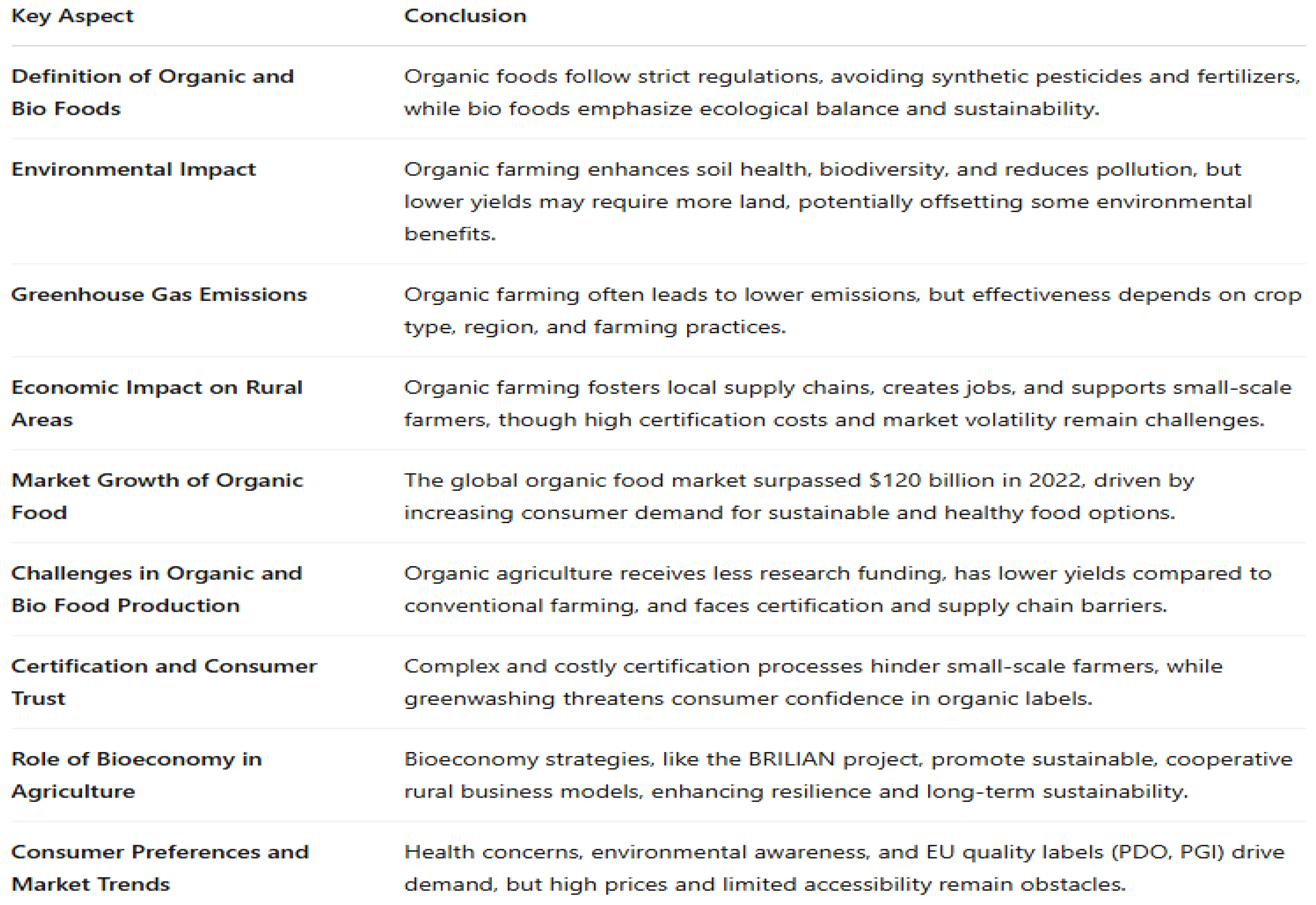
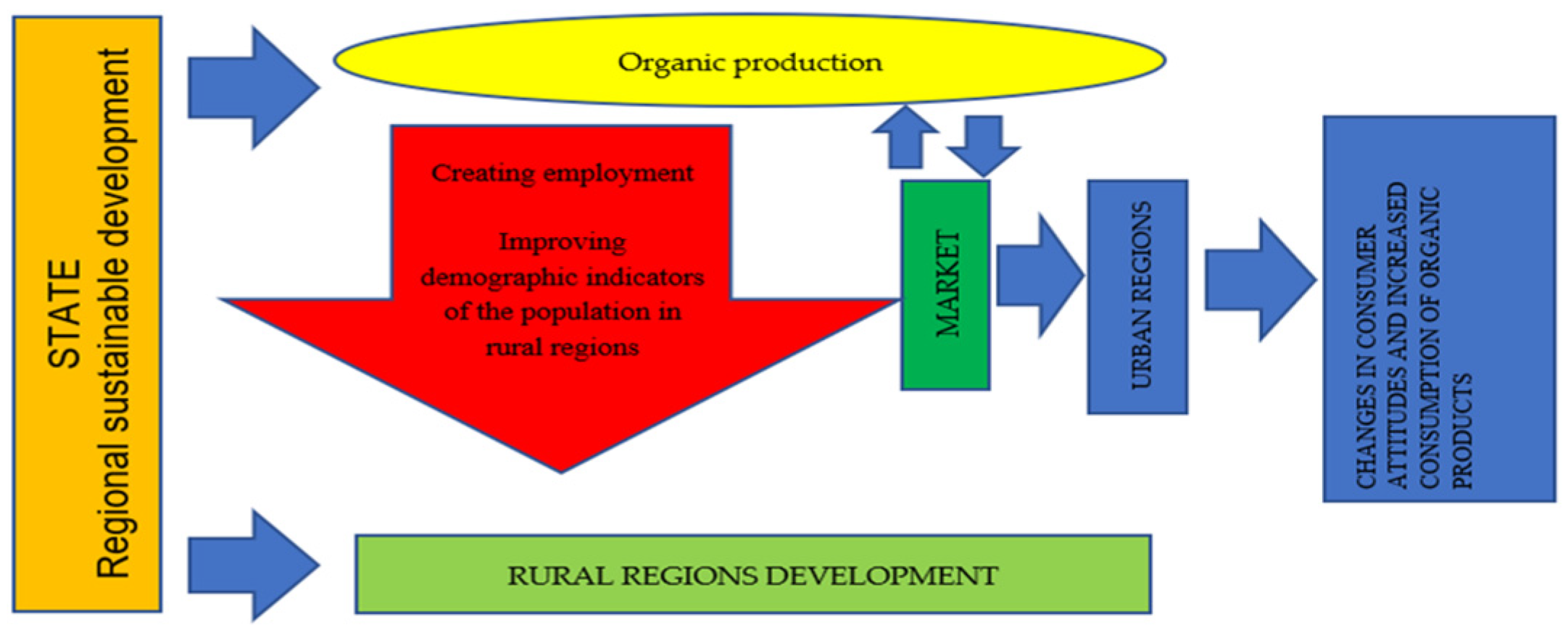
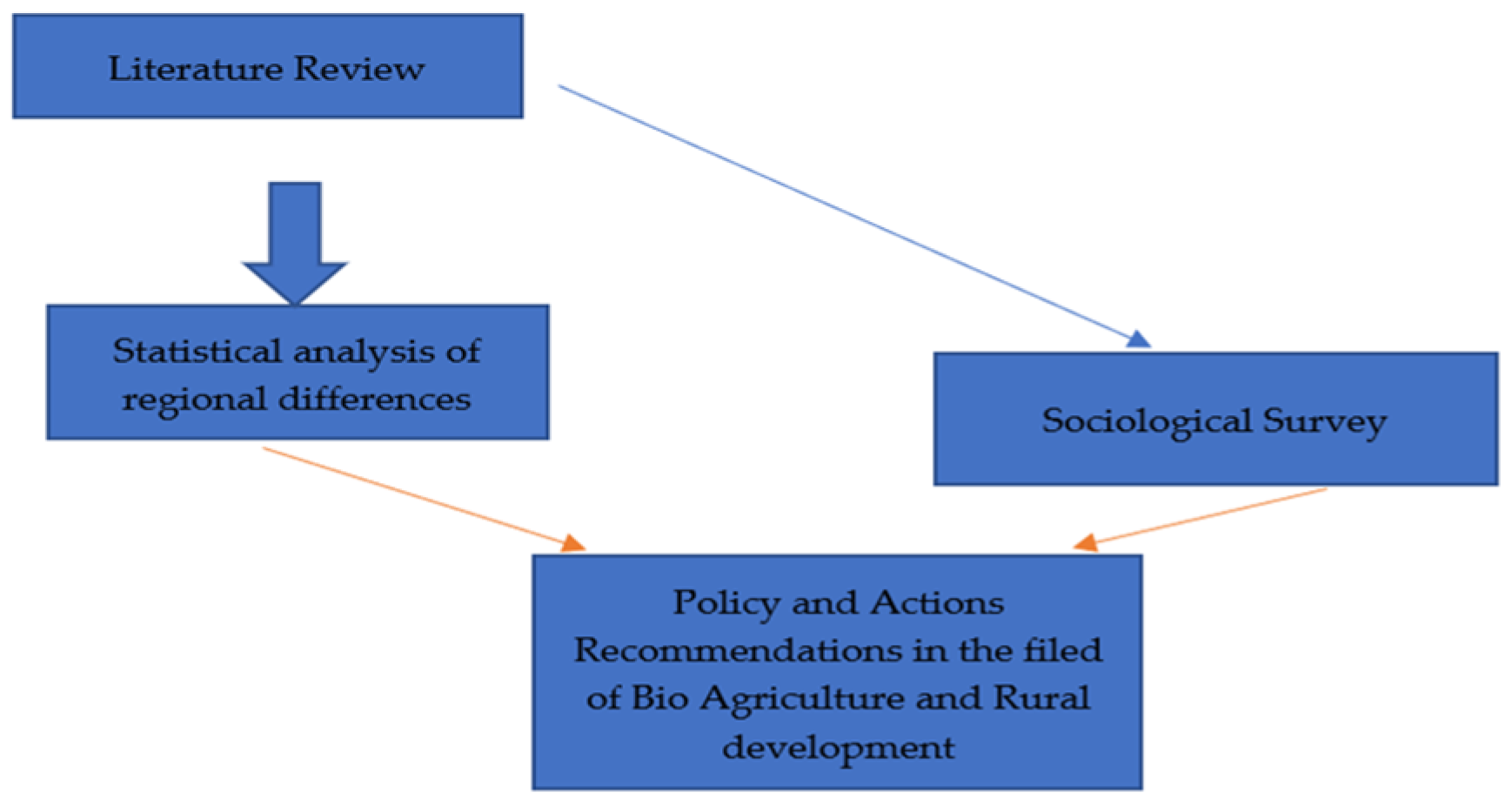
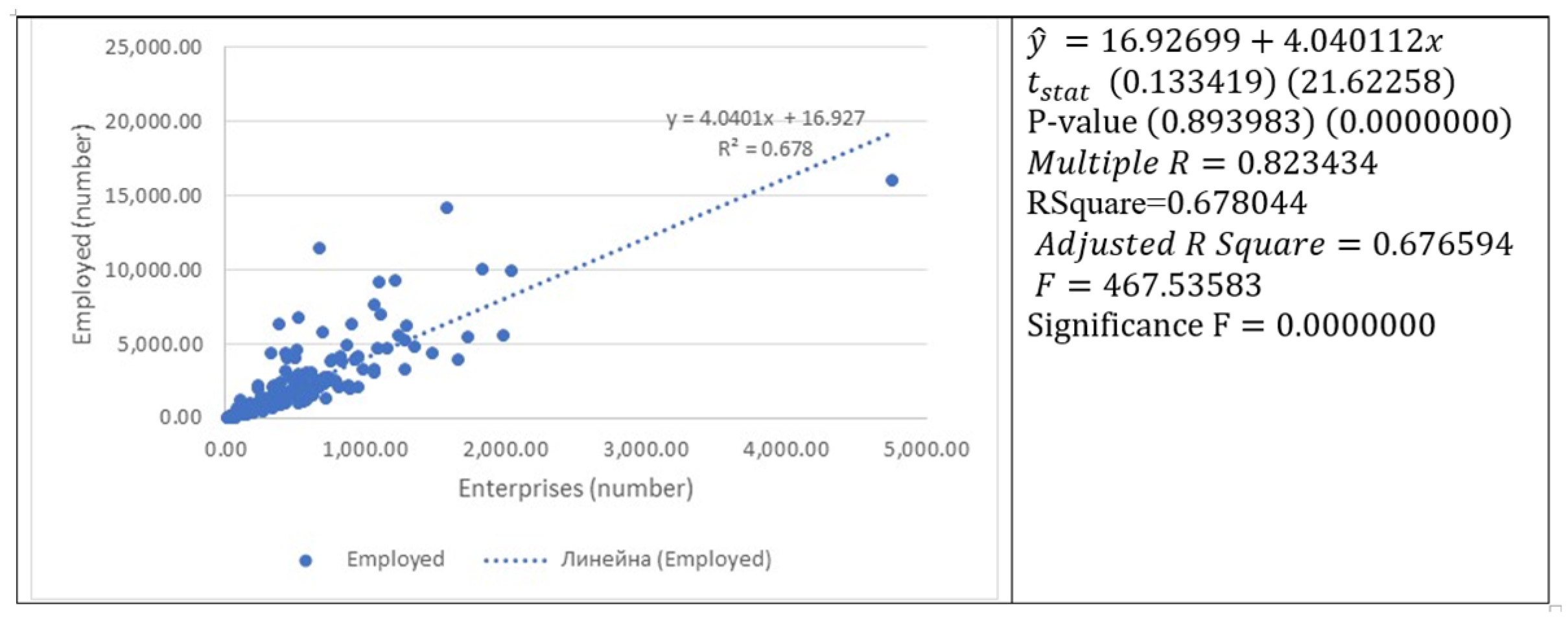
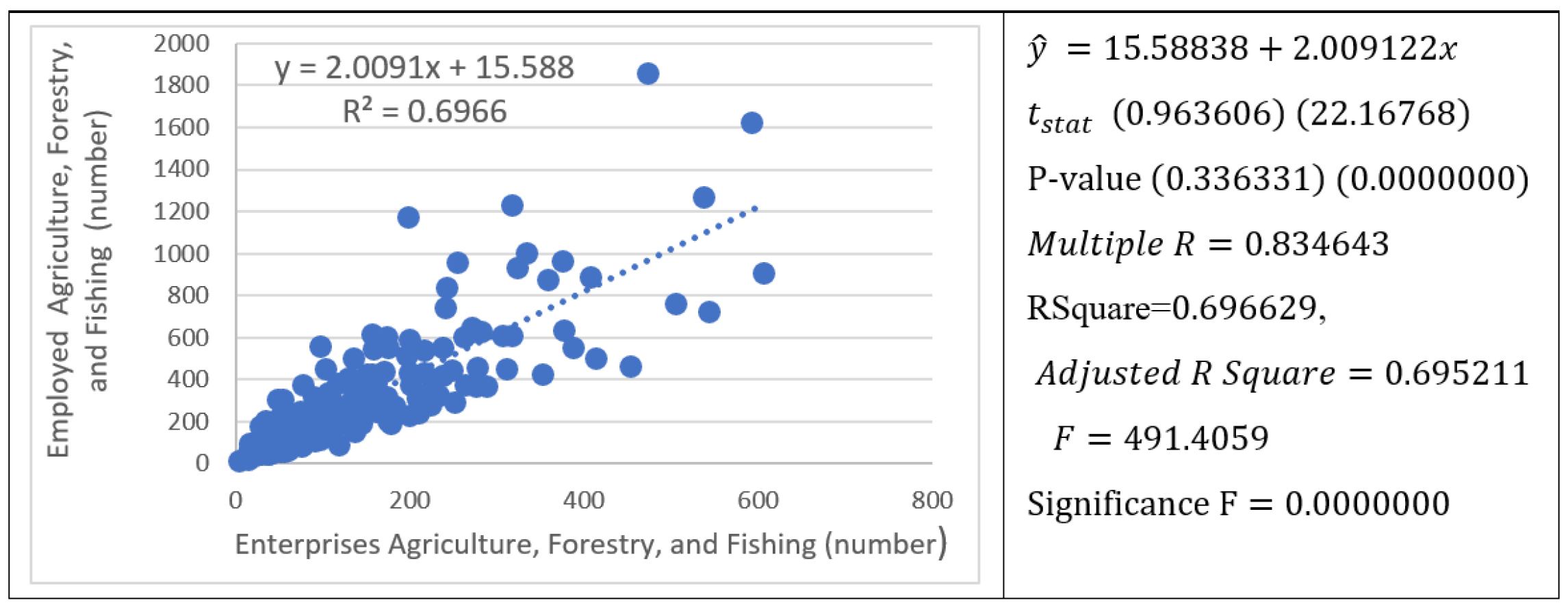
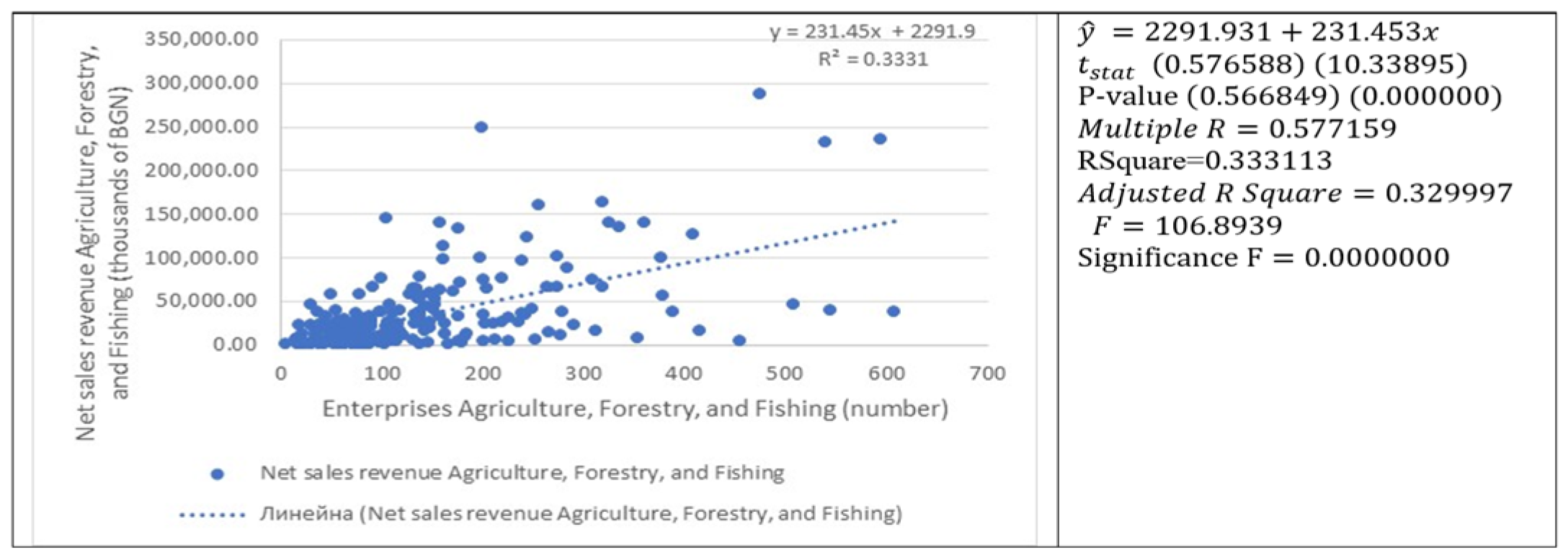
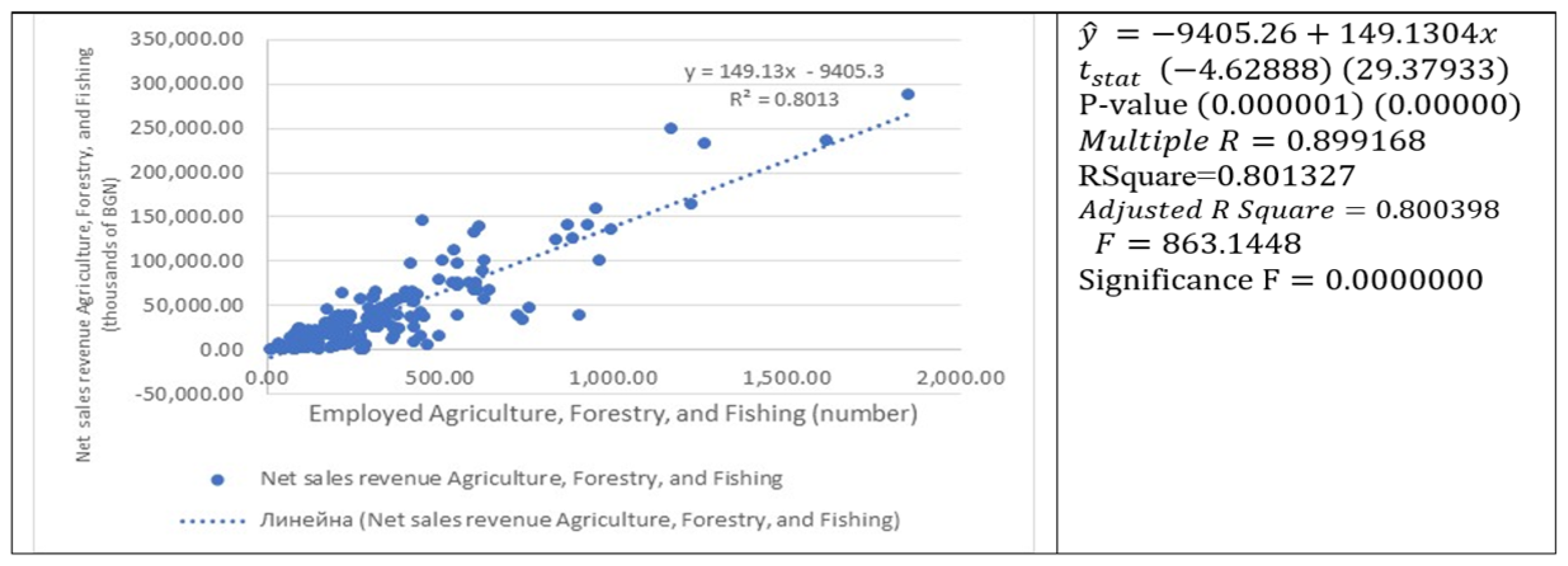
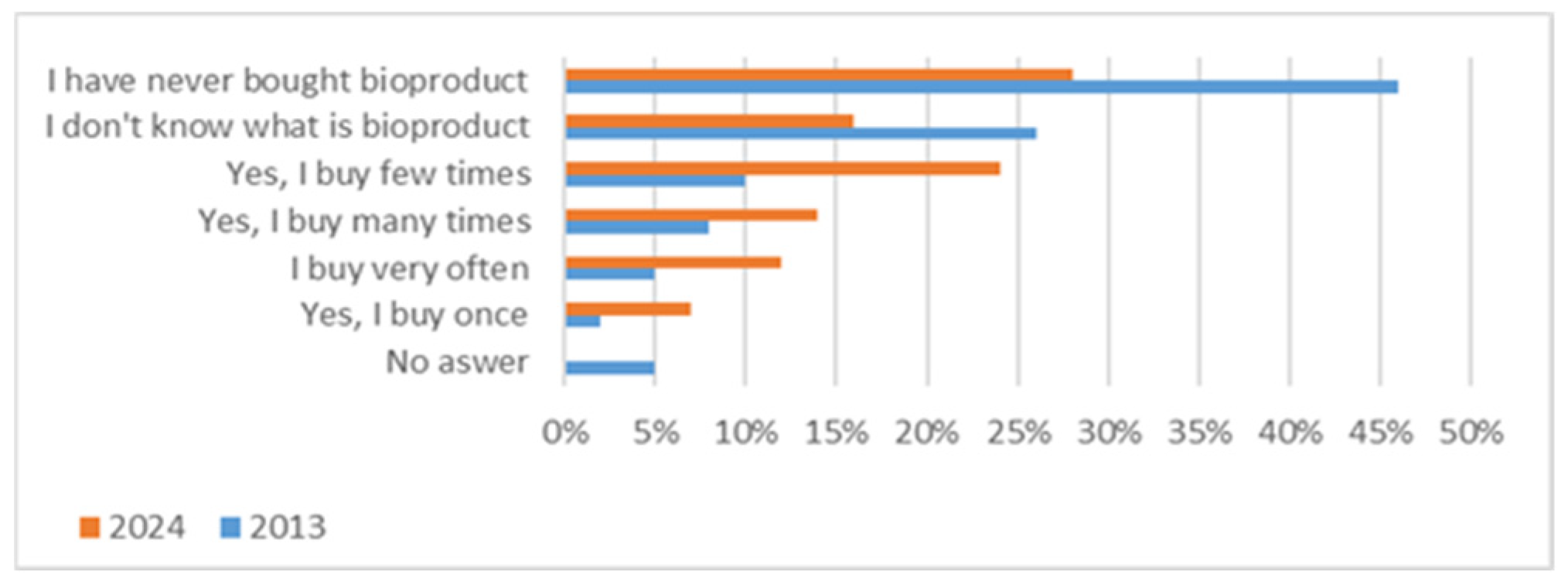


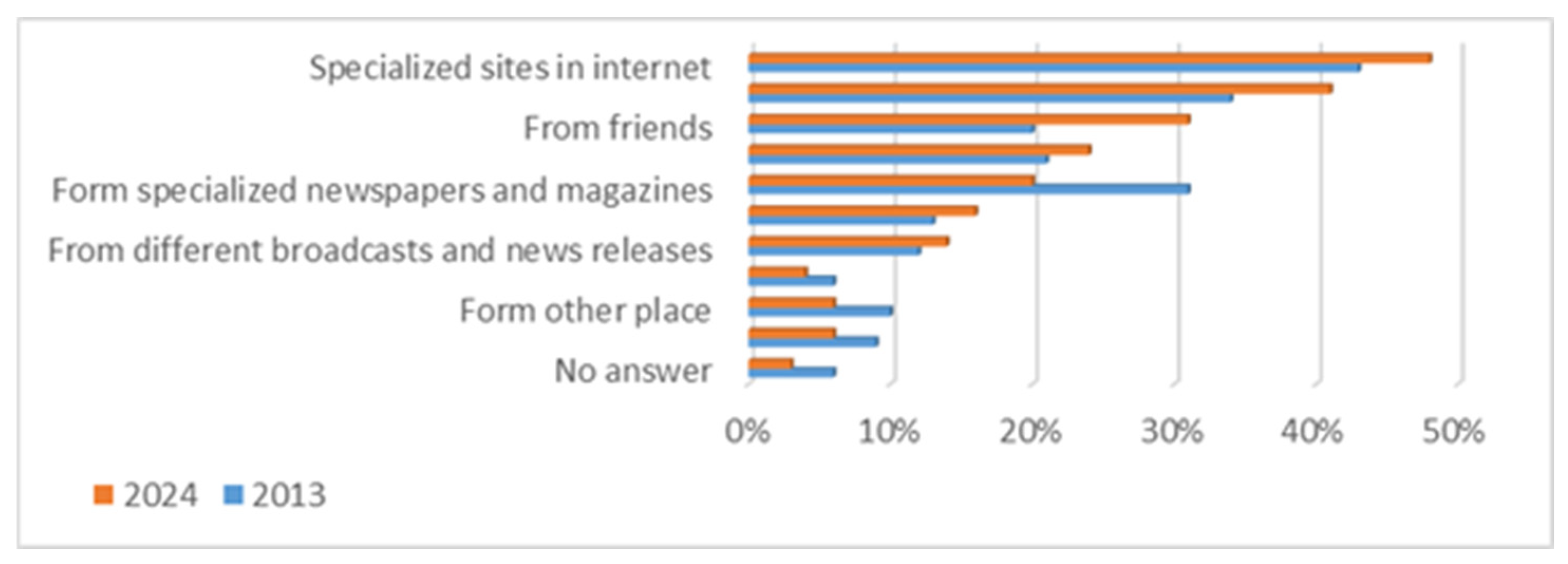

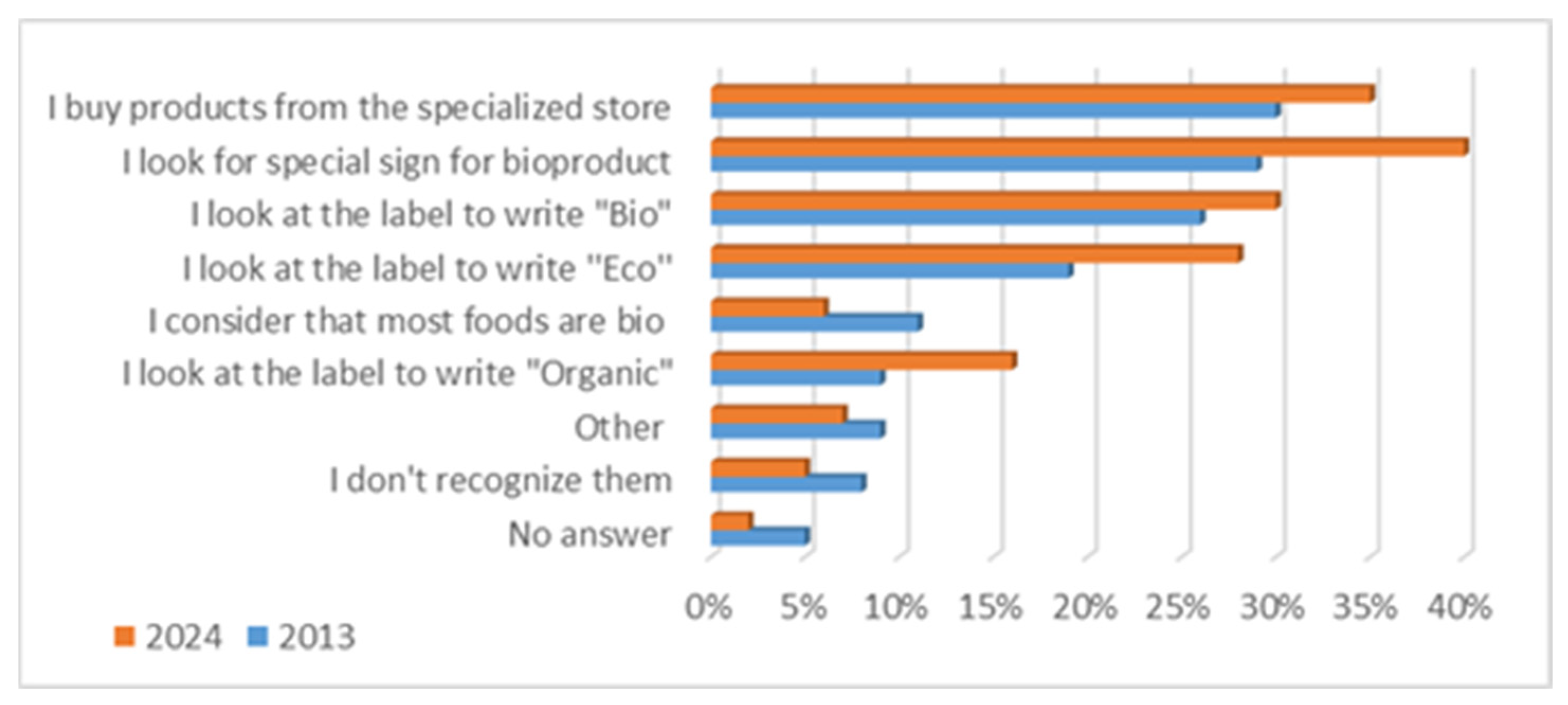
Disclaimer/Publisher’s Note: The statements, opinions and data contained in all publications are solely those of the individual author(s) and contributor(s) and not of MDPI and/or the editor(s). MDPI and/or the editor(s) disclaim responsibility for any injury to people or property resulting from any ideas, methods, instructions or products referred to in the content. |
© 2025 by the authors. Licensee MDPI, Basel, Switzerland. This article is an open access article distributed under the terms and conditions of the Creative Commons Attribution (CC BY) license (https://creativecommons.org/licenses/by/4.0/).
Share and Cite
Tsonkov, N.; Borisov, P.; Slaveva, K. Evaluation of the Correlation Between the Organic Food Sector and Rural Development in Bulgaria: Case Study. Sustainability 2025, 17, 9546. https://doi.org/10.3390/su17219546
Tsonkov N, Borisov P, Slaveva K. Evaluation of the Correlation Between the Organic Food Sector and Rural Development in Bulgaria: Case Study. Sustainability. 2025; 17(21):9546. https://doi.org/10.3390/su17219546
Chicago/Turabian StyleTsonkov, Nikolay, Petar Borisov, and Krasimira Slaveva. 2025. "Evaluation of the Correlation Between the Organic Food Sector and Rural Development in Bulgaria: Case Study" Sustainability 17, no. 21: 9546. https://doi.org/10.3390/su17219546
APA StyleTsonkov, N., Borisov, P., & Slaveva, K. (2025). Evaluation of the Correlation Between the Organic Food Sector and Rural Development in Bulgaria: Case Study. Sustainability, 17(21), 9546. https://doi.org/10.3390/su17219546







